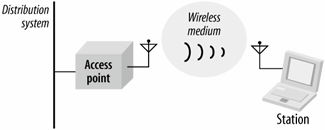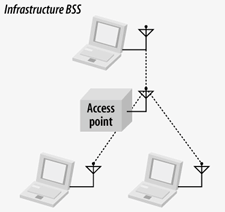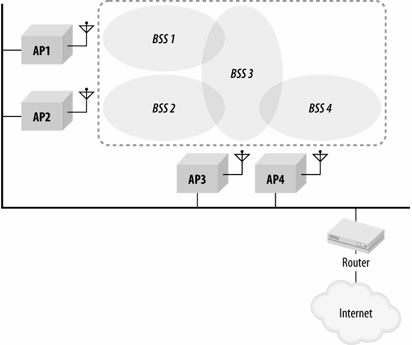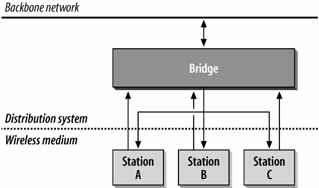802.11 Network Structures
zuallererst sollten wir mal die struktur festlegen (is jetz die ausm skript), sprich sachen rausstreichen, dann den ganzen kram befüllen ...--Cb 20:52, 11 July 2006 (CEST)
Traditional 802.11
- 802.11 =
- „wireless ethernet“
- Wi-fi (from Wi-Fi Alliance, wireless fidelity)
IEEE 802.11 as part of IEEE 802
- IEEE 802.11x =
- IEEE = Institute of Electronics and Electrical Engineers
- 802 = project group (Entwicklung von LAN-Standards)
- 11 = working group (Entwicklung eines wireless-LAN Standards)
- x = task groups
- erstmalige Spezifikation 1997, Änderungen 802.11-1999, 802.11-2003
- the 802.11 Task Groups:
| 802.11 | First standard (1997). Specified the MAC and the original slower frequency-hopping and direct-sequence modulation techniques. |
| 802.11a | Second physical layer standard (1999), but products not released until late 2000. |
| 802.11b | Third physical layer standard (1999), but second wave of products. The most common 802.11 equipment as the first book was written. |
| TGc | Task group that produced a correction to the example encoding in 802.11a. Since the only product was a correction, there is no 802.11c. |
| 802.11d | Extends frequency-hopping PHY for use across multiple regulatory domains. |
| TGe (future 802.11e) | Task group producing quality-of-service (QoS) extensions for the MAC. An interim snapshot called Wi-Fi Multi-Media (WMM) is likely to be implemented before the standard is complete. |
| 802.11F | Inter-access point protocol to improve roaming between directly attached access points. |
| 802.11g | Most recently standardized (2003) PHY for networks in the ISM band. |
| 802.11h | Standard to make 802.11a compatible with European radio emissions regulations. Other regulators have adopted its mechanisms for different purposes. |
| 802.11i | Improvements to security at the link layer. |
| 802.11j | Enhancements to 802.11a to conform to Japanese radio emission regulations. |
| TGk (future 802.11k) | Task group to enhance communication between clients and network to better manage scarce radio use. |
| TGm | Task group to incorporate changes made by 802.11a, 802.11b, and 802.11d, as well as changes made by TGc into the main 802.11 specification. (Think "m" for maintenance.) |
| TGn (future 802.11n) | Task group founded to create a high-throughput standard. The design goal is throughput in excess of 100 Mbps, and the resulting standard will be called 802.11n. |
| TGp (future 802.11p) | Task group adopting 802.11 for use in automobiles. The initial use is likely to be a standard protocol used to collect tolls. |
| TGr (future 802.11r) | Enhancements to roaming performance. |
| TGs (future 802.11s) | Task group enhancing 802.11 for use as mesh networking technology. |
| TGT (future 802.11T) | Task group designing test and measurement specification for 802.11. Its results will be standalone, hence the uppercase letter. |
| TGu (future 802.11u) | Task group modifying 802.11 to assist in interworking with other network technologies. |
- Beziehung von 802.11 zum ISO/OSI-Modell:
- IEEE 802 Spezifikationen beziehen sich nur auf 2 untersten OSI-Layer -> Physical + Data Link Layer
- = MAC + PHY (physical) Komponente
- physical Layers:
- FHSS – frequency-hopping spread-spectrum
- DSSS – direct-sequence spread-spectrum
- mit 802.11b -> HR/DSSS – high-rate DSSS
- mit 802.11a -> OFDM – orthogonal frequency division multiplexing
- 802.11g abwärts-kompatibel zu b, nutzt ausserdem auch OFDM
Structure of a wireless network
- Stationen
- Computer im WLAN
- Access Points
- Bridges: Station <-> Station bzw Station <-> Externe Hosts
- ursprünglich ein Gerät, neuerdings auch „thin“ APs und AP-Controller
- Drahtloses Medium
- DS – Verteilungssystem
Types of Networks
Es gibt mehrere Arten, die Unterschiede aufweisen und teilweise voneinander abhängen.
Grundlage eines wireless LAN ist das BSS:
- Gruppe von Stationen, die miteinander kommunizieren
- Kommunikation innerhalb der BSA (Basic Service Area), durch Ausbreitungseigenschaften der Funkstrahlen definierter Raum.
Independent BSS (IBSS, Ad-Hoc networks)
- direkte Kommunikation der Stationen
- typischerweise für wenige Stationen bzw. geringen Zeitraum etabliert
Infrastructure BSS
- erfordert Benutzung eines AP, jegwede Kommunikation erfolgt über diesen AP
- BSA ist damit als Bereich definiert, in dem mit dem AP kommuniziert werden kann
- damit 2 Hops für Kommunikation von Station zu Station
- Unabhängigkeit von vielen Positionsvektoren (zu den anderen Stationen), nur noch abhängig von Pos. zum AP
- Möglichkeit eines Power-save Modus der Stationen (kurzzeitig PowerOff an den Stationen, AP puffert Frames)
- Association am AP
- novum: multi-BSS oder „virtual APs“
- ein AP bedient mehrere BSS, ESS (mit jeweiliger SSID)
- Abbilden auf VLANs
ESS
- Erweiterung von BSS's, diese werden zu einem ESS zusammengefasst
- jeder AP, der ein BSS in einem ESS bedient, kommuniziert mit den anderen BSS's über ein Backbone-Netzwerk
- Identifikation eines ESS über die SSID (Service Set Identifier = network name)
- sind höchst-levelige Abstaktion in 802.11 Netzwerken
Distribution system
- wenn mehrere APs verbunden sind um ein Netz zu formen kümmert sich dieses um deren Kommunikation
- basiert meist auf Ethernet
- verbindet APs zu einem ESS (DS = logische Komponente in 802.11)
- einhaltet das Backbone-Netzwerk, benötigt jedoch mehr
- Bridge zwischen Wireless Network und Backbone Network
- Inter-Access Point Kommunikation
- jeder AP muss über die Assoziationen aller APs Bescheid wissen
- IAPP – inter-AP-protocol, meist über Backbone-Netzwerk
- IAPP im IEEE 802.11F, wurde jedoch kaum umgesetzt (mittlerweile zurückgezogen) -> zu finden sind oftmals proprietäre Protokolle.
Using the MAC
CSMA/CA
DCF, PCF, NAV
MAC-Zugriffsmodi: Coordination Functions
Timing beim Zugriff auf das MAC: NAV
Interframe Spacing (nur erwähnen)
Network operations and services
Network services overview
Frame format
Frame Arten
Frame Fragmentation
allg. Format
Management
Scanning a Network: Probes and Beacons
Passive Scanning Active Scanning Beacon Frame Probe Request Frame Probe Response Frame Scan Report
Joining a network
1.4.3.2.1 802.11 Authentication 21 1.4.3.2.2 Preauthentication 22 1.4.3.2.3 Association Procedure 22 1.4.3.2.4 Association Request Frame 22 1.4.3.2.5 Association Response Frame 23 1.4.3.2.6 Mobility support: Transitions 23 1.4.3.2.7 Reassociation procedure 24 1.4.3.2.8 Reassociation Request Frame 25 1.4.3.2.9 Association and authentication states 25
Vertraulichkeit und Zugangskontrolle
WEP
802.11i
Controlling the MAC
Control Frames
RTS/CTS
ACK
PS-Poll
Moving data
Prinzipien
1.4.6.1.1 Broadcast Data, Multicast Data und Management Frames 29 1.4.6.1.2 Unicast Data (Management und Daten) 30 1.4.6.1.3 PowerSave Sequenzen 31
Data frames
Distribution
Integration/Encapsulation of ethernet frames
1.4.6.4.1 Prinzip 33 1.4.6.4.2 Ablauf des Bridging zwischen 802.11 und Ethernet 34 wireless2wired 35 wired2wireless 35





